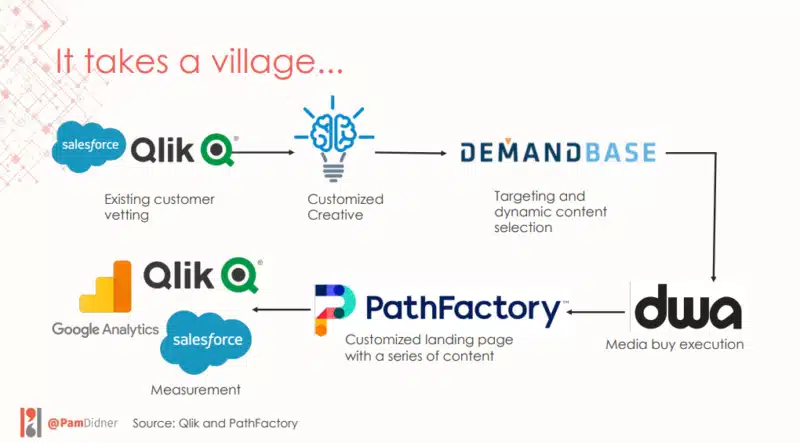How to execute customized ABM campaigns
Use your full range of marketing tools to develop account-specific engagement that supports your sales team.
“Try to think of ABM from the perspective of all the marketing elements that you are using,” said Pam Didner, founder of agency Relentless Pursuit, in her presentation at our most recent MarTech conference. “Think in terms of what you can do to translate and transform these elements to be account-specific kinds of support.”
With better collaboration, and an open mind about what ABM entails, marketers can make a better impact with their B2B strategies. This way, ABM won’t seem like a separate strategy, but can incorporate important pieces of the marketer’s toolkit like email, targeted ads and other messaging.
Defining ABM broadly
“It’s really important that marketers leverage your existing marketing elements creatively to help sales close deals with key accounts,” Didner said.
Using these marketing tools creatively in coordination with sales is the beginning and end of the definition of ABM, according to Didner. However, ABM comes in different forms according to the roles that marketers have and the channels they use.
“If you are in event marketing, you can do account-specific events,” she explained. “If you want to create campaigns, you can think about some creative ideas for your salespeople to engage with key accounts.”
Content marketers can produce standardized content for teams to use, but they can also drill down and create customized content tailored for sales teams, and even for specific key accounts.
Not only that, but the same opportunity applies for email marketing outreach.
“There are a lot of ways you can customize and scale and personalize email for your sales people,” Didner said. “So your ABM strategy depends on what you do, and how you support your sales team.”

ABM as a campaign
ABM’s focus on key accounts does make it more sales-oriented than other marketing strategies. Didner suggests that in order for marketing teams to activate their creativity in support of sales they should think of ABM in terms of campaigns.
“As marketers, you do a lot with campaigns — email marketing campaigns, paid media campaigns and product launches,” said Didner. “What if you can also do a campaign that’s account-specific? You create relevant and customized content.”
She added, “Then you send out the email, but you also do a programmatic paid media campaign to actually drive the traffic, and then you have the ads where this account and the contacts can see. You combine all of this as an account-specific type of marketing campaign.”
With this increased collaboration between marketing and sales, the sales team can also approach marketing with a project. For instance, sales can pull together dormant accounts that might have been inactive for a year or more, and marketing can target a campaign specifically to this segment.
Scaling ABM with technology
B2B marketers already have a lot of moving parts to their operations. Add personalization and customized campaigns to this, and the need to scale becomes critical.
“The challenge for many companies, especially doing ABM, is how can you scale?” Didner said. “The best way to scale is to build a process, and this is where the [technology] stack comes into play.
She added, “You have to build a process before you can scale account-based marketing.”

This means having a connected workflow between team members to build, approve and distribute creative assets. The organization also needs to make sure they have a solid data solution.
Marketing and sales should be plugged into the same CRM on the back end to remain on the same page when key accounts are identified or engaged. Frequently in B2B marketing, prospects are in different verticals, so marketing needs to be able to match the right assets with the right account.
Aligning objectives
Now that sales and marketing are working together on ABM campaigns and other projects, they can talk about higher-level objectives and goals.
To return to the example of sales and marketing working together to engage dormant accounts, they agree on the number of accounts that will be targeted, and they settle on a goal of how many accounts will respond to the campaign.
Let’s say the teams are targeting 200 dormant accounts, and the goal is to hear back from 30 of them.
“In between, you need to fill out the steps that you need to connect point A to point B,” said Didner. “Then build the tools and processes to support that, and also track the results.”
“ABM campaigns require a high degree of collaboration, and a follow-up on the marketing side,” Didner said, though cautioning: “Don’t expect the salespeople to follow up.”
See the full presentation from MarTech here (free registration required)
Account-based marketing: A snapshot
What it is. Account-based marketing, or ABM, is a B2B marketing strategy that aligns sales and marketing efforts to focus on high-value accounts.
This customer acquisition strategy focuses on delivering promotions — advertising, direct mail, content syndication, etc. — to targeted accounts. Individuals who may be involved in the purchase decision are targeted in a variety of ways, in order to soften the earth for the sales organization.
Why it’s hot. Account-based marketing addresses changes in B2B buyer behavior. Buyers now do extensive online research before contacting sales, a trend that has accelerated during the COVID-19 pandemic. One of marketing’s tasks in an ABM strategy is to make certain its company’s message is reaching potential customers while they are doing their research.
Why we care. Account engagement, win rate, average deal size, and ROI increase after implementing account-based marketing, according to a recent Forrester/SiriusDecisions survey. While B2B marketers benefit from that win rate, ABM vendors are also reaping the benefits as B2B marketers invest in these technologies and apply them to their channels.
Dig deeper: What is ABM and why are B2B marketers so bullish on it?
Related stories